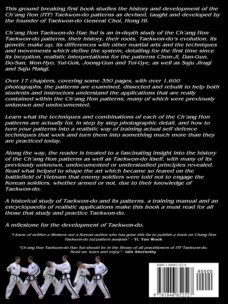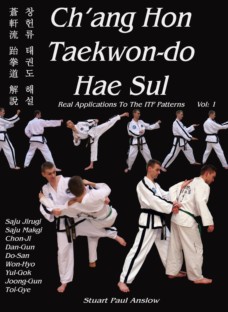Ch'ang Hon Taekwon-do Hae Sul Real Applications To The ITF Patterns Vol: 1 The new book by Stuart Anslow |
Recommended Reading |
Recommended Reading |


Foreword by Iain Abernethy In recent years we have seen an ever growing number of martial artists re-evaluating all aspects of their training. Whereas once people would practise without ever questioning or testing the information received, today’s martial artist wants to fully understand their art. They want to know why the techniques are performed as they are, they want to understand how to correctly apply the techniques, they want to understand the origins and development of their art, and they want to know how to brining it all together to make the art work. This new questioning approach to the martial arts has brought innumerable benefits to all the martial arts and their practitioners. For practitioners of traditional systems, a key benefit has been the growing number of people revaluating the role of Kata, forms and patterns. In many modern schools the forms are used as physical exercise, art for art’s sake, an internal quest for perfection, or even as a “refuge” for those who wish to avoid the martial side of the arts. But is that all they have to offer? Surely, as a key part of the martial arts, they must have a combative function? As a karateka, it always seemed obvious to me that there must be a reason why the formulators and developers of karate insisted that kata were the key to the art. The formulators of karate were fighting men who would have had little time for activities that didn’t directly enhance fighting skill. It is my view that the kata are wholly about recording combative methods and all other “uses” for kata – worthwhile as some of them may be – are modern “spin offs” and not what the kata were created for. My own training and research led me to the conclusion that it is within the kata that the true martial art is found. Study of the kata reveals the close-range strikes, chokes, strangles, throws, grappling, limb-control, locks and a whole host of combative methods that make karate a holistic and pragmatic art. Without an understanding of kata, all the modern martial artist has left is a hollow shell of the original art and the techniques of modern sport. Many others have shared my experience and interest in the combative applications of the kata is growing all the time. People are simply no longer content to practise a “partial art”. I’ve written four books on kata application and made around 20 DVDs on the subject. One of the great things about producing such material is that they have brought me into contact with many other martial artists who have also written, or are writing, books to share their approaches to kata application. For me, it’s really exciting to see all this great information being openly shared and made so widely available! Due to the rise in a questioning approach to the martial arts, and the increasing availability of information, there has never been a better time for those who practise kata to understand just what they were created for and how the information recorded in them can be extracted and used in combat. My own martial background is firmly grounded in traditional karate. To the uninitiated, karate is considered to be a single martial art with a uniform way of doing things. The reality, however, is that “karate” is a coverall term for a wide range of combative systems originating from Okinawa. Whilst the traditional karate systems have a great deal in common, they also have many differences. One of the key differences between the many karate systems is the kata that they use and the way in which those kata are performed. Thankfully, there are many experienced karateka, from a wide range of the styles, exploring kata application. This has meant that there is a good amount of quality information available on almost all karate systems, karate kata and their many variations. However, sadly there is still relatively little information available on the application of the Taekwon-do patterns. Taekwon-do practitioners who have an interest in the application of the patterns sometimes therefore find themselves having to adapt the karate applications to fit their forms. This is obviously not ideal. Karate and Taekwon-do have some common ground (the Shotokan karate system being one of Taekwon-do’s roots) and therefore the information available on the karate kata will have some relevance to the motions in the Taekwon-do forms. However, Taekwon-do has its own unique forms, and its own unique way for performing the movements that make up those forms. It is for that reason that books such as this one are so very important. Books like this one have a great deal to offer Taekwon-do practitioners as they will allow them to access parts of their art which would otherwise remain locked away within the patterns. Stuart Anslow is to be congratulated for sharing his approach to Taekwon-do patterns in this way. By doing so, he is doing a great service to Taekwon-do practitioners and the art itself. Reading through the pages of this book makes it abundantly clear just how much thought, time and effort Stuart Anslow has put into examining the ITF patterns. Not only does this book detail applications for the motions within these patterns, it also explores the background to each form and, perhaps most importantly, it also details the thought process that gave rise to the applications shown. Stuart has a clear and engaging writing style and the book is beautifully presented. I feel certain that this book will have Taekwon-do practitioners looking at their patterns from a new angle and with renewed enthusiasm. Ch’ang Hon Taekwon-do Hae Sul should be in the library of all practitioners of ITF Taekwon-do. Read on, learn and enjoy! Iain Abernethy 2006 5th Dan Karate (British Combat Association and Karate England). |
Book Details Over 350 pages 17 Chapters (plus 7 Appendix’s) Over 1,600 pictures and photographs, Soft Cover*, with perfect binding, 8.5" x 11", approx weight 900g |


